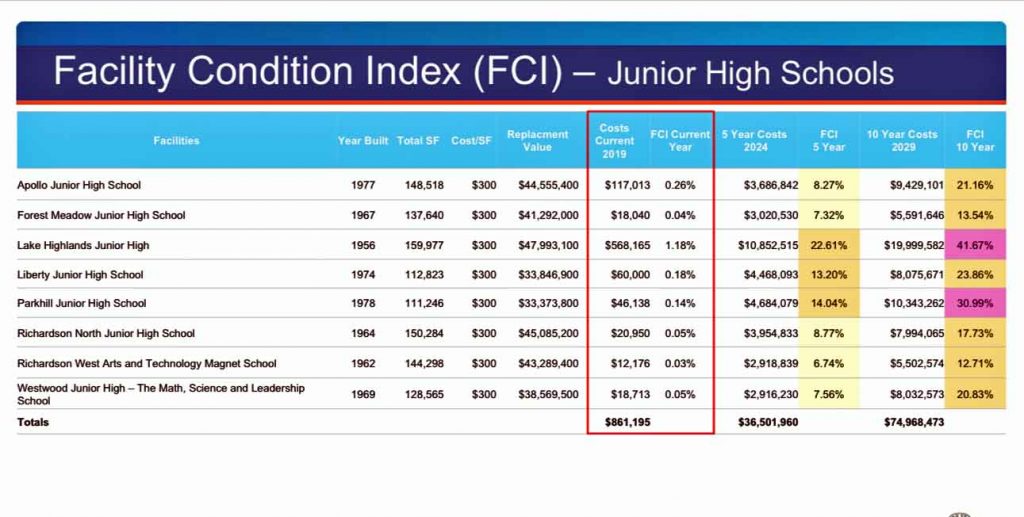If you’re feeling nostalgic about the Lake Highlands Junior High building where you or your children went to class, you may not have long to pay the 64-year-old school a visit. A new facilities assessment commissioned by Richardson ISD says the school district’s oldest junior high building is inefficient and expensive to maintain. As RISD begins planning for the 2021 bond, school officials have a decision to make – whether to continue repairing and replacing outdated systems or tear the building down and start anew on the LHJH campus.
While the Program Planning Committee (PPC), comprised of parents, staff, community reps and administrators, examines efficiency and cost, other issues are brewing. The district’s Grade Configuration Committee (GCC) is considering whether to institute a new middle school model by moving sixth graders out of elementary and onto junior high campuses. Although RISD officials say educational outcomes will be paramount in their decision-making process, enrollment growth throughout the district is driving discussions on the need for space.
As if these issues weren’t complicated enough, RISD is searching for classrooms for their new Pre-K For All program, set to begin implementation in the fall. The district began crafting, then the State of Texas mandated, free Pre-K for students who qualify based on socio-economic need and other factors. In time, RISD will also offer tuition-based Pre-K for all who wish to enroll. The program will be hosted on 25 campuses, not all 41 RISD elementaries, but moving sixth graders would free up classrooms for the initiative. Implementing the middle school model would require construction at all 8 RISD junior highs but be more efficient than adding onto numerous elementary schools.
No decisions have been made yet, stressed RISD Assistant Superintendent of Operations Sandra Hayes, but LH’s original junior high is at the tip of the spear.
“Lake Highlands Junior High is being targeted because of the age and condition of the facility and the complaints we get about the campus regularly,” Hayes said. “It’s just one work order after another. Things keep breaking down – the mechanical systems, the boiler room, the HVAC, the electrical. The halls were built narrower than halls are built today – it’s a whole range of issues. The roof, the foundation, all kinds of things. Rather than ask the community to give us $20 million just to maintain the existing campus as it is with no changes, no additions, no beautifications – that’s almost half of what it costs to replace it. We have a large greenspace there, so we can build simultaneously, which is what a lot of districts do.”
Most school buildings were originally built to last 50 years or so, and surrounding districts vary in their approach.
“Plano has what they call the 20/40 Rule,” says Hayes. “After 20 years they pretty much gut the inside of their buildings and totally redo them. After 40 years, they tear them down and rebuild. Dallas ISD historically keeps their buildings until the very last, but then they don’t maintain them to the standard that our community would expect. Frisco is building all new, because they are having so much growth. Every district looks at it differently.”
“We’re at a point that we have many buildings that are becoming very old,” agreed RISD Director of Communications Tim Clark, who said the facility conditions audit, campus capacity study and demographer’s report would be key factors in bond planning. “They help us know what campuses have reached a point where we have to ask the question, ‘does it make sense to continue to bleed money to keep this campus running when it doesn’t serve the needs of kids today, though it may have served the needs of kids in the 1950s or 60s. Does it make more sense for us to build a new school to provide what students need, as opposed to spending a smaller portion of money just to keep it going 10 or 15 years.”
If a new LHJH is constructed, RISD would build on the athletic field toward Plano Road while the school continues to operate. Then the old building would be demolished and a new field built when the kids move over. During the design phase, the PPC would work closely with architects to determine what bells and whistles might be desirable in a new school building.
“That’s critical for us,” said Clark, “because it’s been a very long time since RISD built a junior high. Parkhill was built in 1978, so the expertise that an architectural firm with experience in building junior highs and middle schools brings will be key to that process.”
LHJH was built in 1956, but it’s not the oldest junior high in the district. RISD’s administration building originally housed grades 1-12 for the entire district and is more than 100 years old. The current MST (Math, Science and Technology) Elementary first served as Richardson High, then Richardson Junior High.
As word of the possibility of tearing down LHJH has begun leaking out, some alums and parents have said they’d be sad to see the old building go. Others expressed excitement about potential options to come. A few districts, such as Highland Park ISD, have preserved and incorporated elements when schools were torn down and rebuilt, and Clark said the community and architects can decide if that makes sense for LHJH. “There are emotions involved,” he acknowledged.
The district has hired Perkins and Will, the architectural firm which designed the White Rock Elementary addition, to conceptualize options for LHJH. The various committees will share recommendations with the Community Bond Committee, which will report to RISD trustees with potential line items for Bond 2021.
“By most reasonable measures, it would be difficult for anyone to argue that the district hasn’t realized its investment, and then some, over the years,” said Clark. “There does come a time, as instruction changes and expectations change and building codes change, that we need to do what’s right for the kids.”






